#Hardik Resort
Link
0 notes
Text
7 Celebrities-Handpicked Wedding Destinations in Rajasthan | Fotographiya
Here we have enlisted the top 7 sizzling wedding destinations in Rajasthan handpicked by celebrities like Parineeti Chopra, Kiara Advani, Katrina Kaif...
Yo, folks!
In recent years, Rajasthan, the land of timeless tales, vibrant culture, and grandeur, has emerged as a favored destination for both modern couples seeking the wedding of their dreams and famous celebrities looking to add a touch of royalty to their special day. Its ancient forts, opulent palaces, and sprawling landscapes serve as the perfect canvas for crafting weddings that are nothing short of spectacular.
As we delve into the top 7 wedding destinations handpicked by celebrities, you'll see that Rajasthan's charm isn't confined to the pages of history—it's very much alive in the present. From the breathtaking Leela Palace in Udaipur to the regal Taj Umaid Bhawan Palace in Jodhpur, each of these venues has played host to star-studded weddings that have left the world in awe. These stunning destinations aren't just Instagrammable; they're where our favorite stars decided to say "I do" in style. And you know what? They're nothing short of epic!
1. Leela Palace, Udaipur - Parineeti Chopra and Raghav Chadda's Epic Spot
Picture yourself amidst the shimmering waters of Lake Pichola, surrounded by the Aravalli Mountains. That's the breathtaking backdrop that made Parineeti Chopra and Raghav Chadda choose the Leela Palace, Udaipur for their nuptials. With its regal architecture and pristine gardens, this luxury resort exudes elegance and promises a wedding fit for royalty. It's like stepping into a fairy tale, and their wedding was a headline-making love story. This luxury resort is goals, with regal vibes and Insta-worthy gardens that scream royalty.
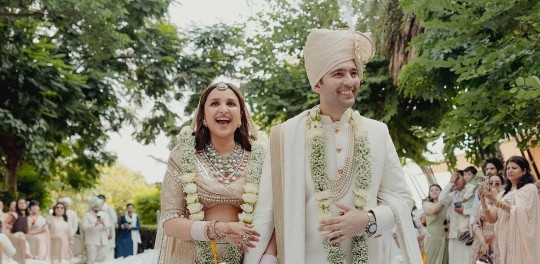
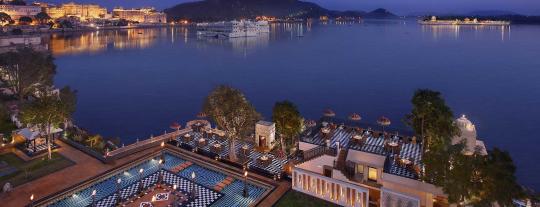
2. Suryagarh, Jaisalmer - Siddharth Malhotra-Kiara Advani, the Shershah Couple
The "Shershah" of Bollywood, Sidharth Malhotra, and the ever-charming Kiara Advani took their wedding vows amidst the golden sands of Jaisalmer at the Suryagarh. This fortress-like hotel mirrors the beauty and valor of Rajasthan, offering a unique blend of luxury and tradition that made their wedding a true fairytale affair. This fortress-style hotel is the bomb dot com, combining ancient vibes with modern luxury. Their wedding? Straight-up magical!
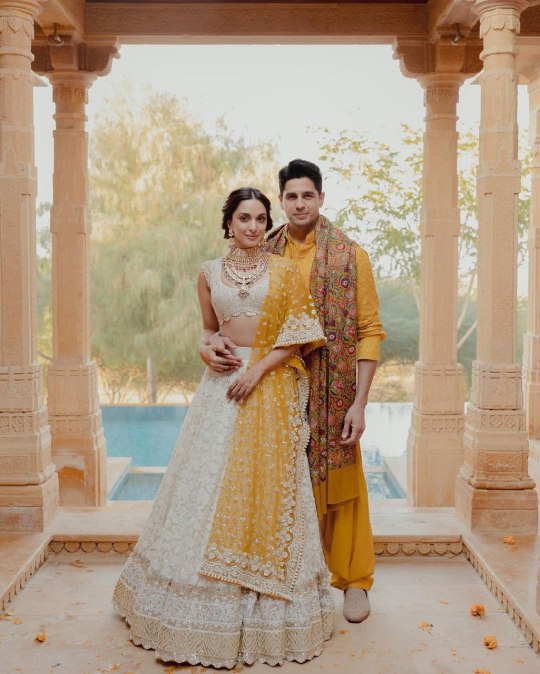
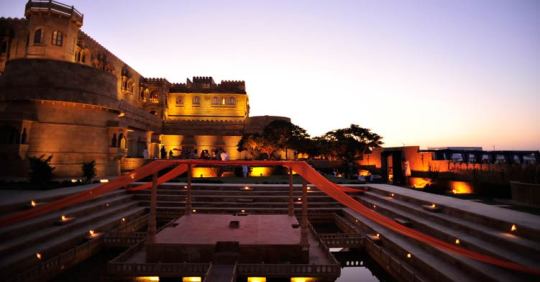
3. Raffles, Udaipur - Hardik Pandya and Natasa Stankovic's Swaggy Affair
This palace-turned-hotel is all about romance, with serene courtyards and top-notch swag. The resort recently witnessed a popular wedding of Ace cricketer Hardik Pandya and model-actor Natasa Stankovik. The couple renewed their vows in a lovely ceremony in Udaipur on Tuesday, February 15th, 2023. The ceremony followed Christian rituals, which meant that Natasa was dressed in a pristine white bridal gown while Pandya put his dapper foot forward in a classic black tuxedo. Later that evening, the couple shared a glimpse of their celebration on Instagram with the caption, “We celebrated Valentine’s Day on this island of love by renewing the vows we took three years ago".


4. Six Senses Fort, Barwara - Katrina Kaif and Vicky Kaushal
The resort is set in a 14th-century fort, and it is surrounded by stunning desert views. It is the perfect setting for a destination wedding, and it is no wonder that the resort is a popular choice for couples from all over the world. The resort also has a team of experienced wedding planners who can help you create the perfect wedding day. They will work with you to choose the perfect event space, the perfect menu, and the perfect decorations
Katrina Kaif and Vicky Kaushal had their love story unfold at Six Senses Fort in Barwara. It's where Heritage meets wellness, and their wedding was all kinds of chill and fabulous.

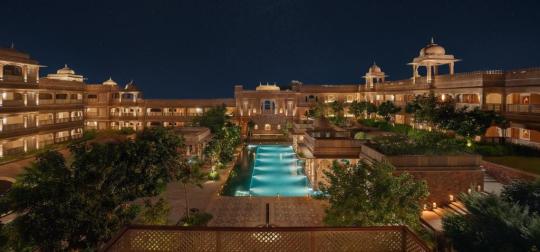
5. Taj Umaid Bhawan Palace, Jodhpur - Priyanka Chopra and Nick Jonas
The palace is a stunning example of Rajput architecture, and it is decorated with intricate carvings and paintings. The palace has 347 rooms, including a grand ballroom, a museum, and a library. The palace also has a number of gardens, including a zen garden and a rose garden
The resort was a host to the wedding of another popular couple Nick Jonas and Priyanka Chopra. The fact that the wedding brought together two of the biggest fandoms in the world is a testament to the couple's star power and popularity. When they tied the knot at the Palace, it was straight-up royalty meets Hollywood glam. Lush gardens, Blue City views - this place has it all, and their wedding was a global sensation.
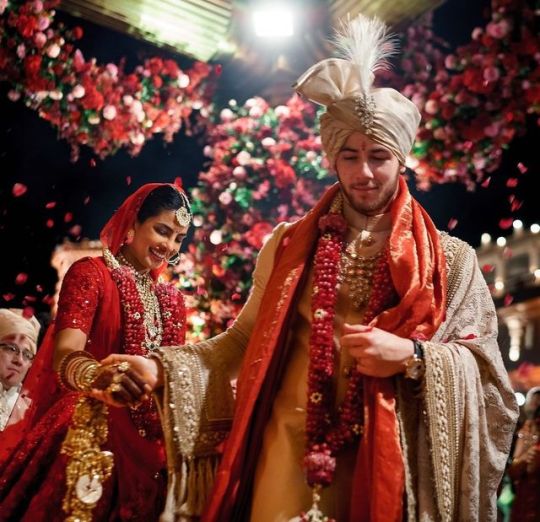

6. Radisson Blu Palace Resort and Spa, Udaipur- Neil Nitin Mukesh and Rukmini Sahay
Radisson Blu Palace Resort and Spa is a luxurious resort located in Udaipur, Rajasthan, India. The resort is known for its stunning lakeside location, its beautiful architecture, and its impeccable service.
Neil Nitin Mukesh and Rukmini Sahay are one of the most beloved couples in Bollywood. They met through their parents, who are both actors, and they have been together for over a decade. They finally tied the knot in a private ceremony in Udaipur, Rajasthan, in 2017. They chose Radisson Blu Palace Resort for their big day. This spot nails the mix of tradition and modern luxury. With Insta-worthy gardens and stunning lakeside views, it's perfect for couples who want to slay the wedding game.

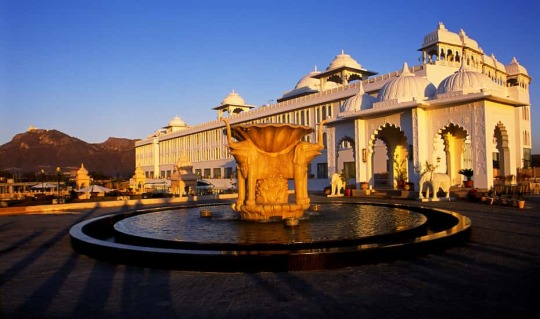
7. Shiv Niwas Palace - Raveena Tandon and Anil Thadani
The Shiv Niwas Palace in Udaipur is a testament to timeless romance. Celebrities have often chosen this palace for its intimate, regal charm. With its exquisite architecture and breathtaking views of Lake Pichola, it's the perfect place for couples who want to embark on their marital journey in a setting straight out of a storybook.
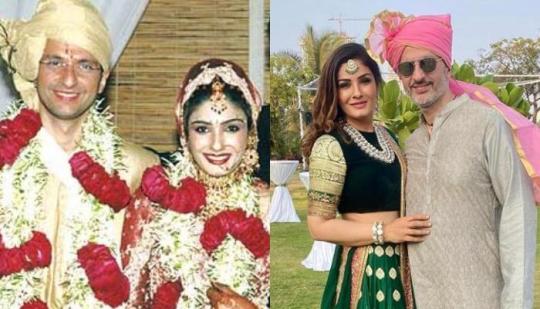

As you've witnessed the glitz and glamour of celebrity weddings and the enchanting allure of Rajasthan, we hope you're inspired to pen your own love story in this land of kings and queens. Whether you're a celebrity or a couple with stars in your eyes, Rajasthan welcomes you with open arms to craft a wedding that transcends time and leaves a legacy of love.
So, dream big, love fiercely, and make Rajasthan the backdrop of your own unforgettable love story. Because here, in the embrace of tradition and modernity, your wedding becomes a masterpiece that will be celebrated for generations to come. Rajasthan beckons and your love story awaits its grand finale in this land of timeless allure.
#wedding#photography#indian wedding#fotographiya#celebritywedding#priyanka chopra#nick jonas#sidkiara
0 notes
Text
Deluxe rooms in Mussoorie
If you are planning to visit the picturesque hill station of Mussoorie, make sure to book a deluxe room to enhance your vacation experience. Deluxe rooms in Mussoorie offer luxurious amenities, stunning views, and top-notch hospitality. In this article, we will explore everything you need to know about deluxe rooms in Mussoorie, from their features and benefits to the best hotels that offer them.

1. What are deluxe rooms in Mussoorie?
Deluxe rooms in Mussoorie are spacious and elegantly designed rooms that offer a higher level of comfort and luxury than standard rooms. They are often equipped with additional amenities such as a king-size bed, a sitting area, a private balcony with scenic views, and modern amenities like flat-screen TVs, mini-fridges, and air conditioning.
2. Benefits of staying in a deluxe room in Mussoorie
Staying in a deluxe room in Mussoorie comes with several benefits. Firstly, they offer a more comfortable and luxurious stay compared to standard rooms. Secondly, deluxe rooms are often located in the best areas of hotels, providing breathtaking views of the surrounding mountains and valleys. Additionally, the extra space and amenities offered by deluxe rooms make them an ideal choice for families or groups of friends traveling together.
3. Best hotels with deluxe rooms in Mussoorie
Mussoorie boasts a plethora of hotels that offer deluxe rooms to their guests. Some of the best hotels with deluxe rooms in Mussoorie are:
Hardik Hospitality
Hardik Hospitality is a renowned hospitality company based in Delhi, India. With a focus on providing exceptional services and experiences, the company manages several hotels, resorts, and restaurants across the country. Their properties are known for their world-class amenities, luxurious accommodations, and impeccable service. With a dedicated team of professionals, Hardik Hospitality strives to exceed their guests' expectations and deliver unforgettable experiences. Whether you're looking for a relaxing getaway, a business trip, or a special occasion, Hardik Hospitality has something for everyone.
4. How to choose the best deluxe room in Mussoorie?
When choosing a deluxe room in Mussoorie, there are a few factors to consider. Firstly, consider the location of the hotel and the view from the room. Secondly, look for rooms that offer ample space and modern amenities like flat-screen TVs, minibars, and air conditioning. Additionally, consider the hotel's reputation and customer reviews to ensure that you have a comfortable and hassle-free stay.
5. How much do deluxe rooms in Mussoorie cost?
The cost of deluxe rooms in Mussoorie varies depending on the hotel and the season. During peak season, deluxe rooms can cost anywhere from INR 10,000 to INR 30,000 per night. However, during the off-season, the prices can drop significantly, with some hotels offering deluxe rooms for as low as INR 5,000 per night.
6. Tips for booking a deluxe room in Mussoorie
When booking a deluxe room in Mussoorie, it is important to book in advance, especially during peak season. Additionally, look for deals and discounts offered by hotels to save money on your stay. Finally, make sure to check the hotel's cancellation policy to avoid any cancellation fees or penalties.
7. Conclusion
If you are planning to visit Mussoorie, a deluxe room is the perfect accommodation choice for a comfortable and luxurious vacation experience. With spacious rooms, stunning views, and modern amenities, deluxe rooms in Mussoorie offer the ultimate comfort and relaxation. Consider the factors mentioned above to choose the best deluxe room and book in advance to secure the best deals. We hope this article has helped you understand the benefits and features of deluxe rooms in Mussoorie, and we wish you a memorable stay in this beautiful hill station.
FAQs
What amenities are included in a deluxe room in Mussoorie?
Deluxe rooms in Mussoorie offer additional amenities such as a king-size bed, a sitting area, a private balcony with scenic views, and modern amenities like flat-screen TVs, mini-fridges, and air conditioning.
Are deluxe rooms in Mussoorie more expensive than standard rooms?
Yes, deluxe rooms in Mussoorie are typically more expensive than standard rooms due to their larger size, additional amenities, and prime location.
What is the best time to book a deluxe room in Mussoorie?
It is best to book a deluxe room in Mussoorie well in advance, especially during peak season, to secure the best deals and avoid any last-minute hassles.
What is the average cost of a deluxe room in Mussoorie?
The cost of a deluxe room in Mussoorie varies depending on the hotel and the season, with prices ranging from INR 5,000 to INR 30,000 per night.
Can I get a discount on a deluxe room in Mussoorie?
Yes, many hotels offer deals and discounts on deluxe rooms, especially during the off-season. Make sure to check for any ongoing promotions and book directly with the hotel to get the best rates.
0 notes
Photo
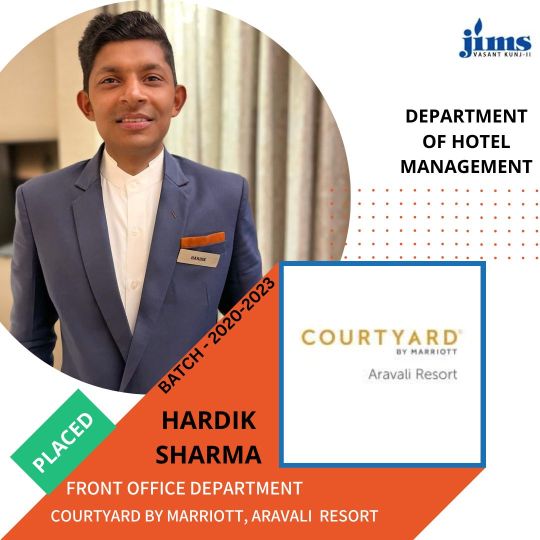
CONGRATULATIONS, Hardik Sharma !!!
We are really happy to announce Hardik Sharma, a student of JIMS VK II, Department of Hotel Management has successfully been placed at the hotel Courtyard By Marriott, Aravali Resort in Front Office Department. We wish him a bright future ahead.
0 notes
Text
Hardik Pandya's Health Secret: Moong Dal Khichdi, Perfected by His Touring Chef
Hardik Pandya’s Health Secret: Moong Dal Khichdi, Perfected by His Touring Chef
A easy moong dal and rice khichdi. Temper it with some gentle spices and ghee. Semi-dry, however all the time served sizzling. The homely aroma of this easy consolation meals is coming from an condominium close to resorts in Australia the place the Indian group is staying with Hardik Pandya.
Packed in a tiffin, this merely soothing gas of power drives India’s most torturous all-rounder Pandya –…
View On WordPress
0 notes
Photo
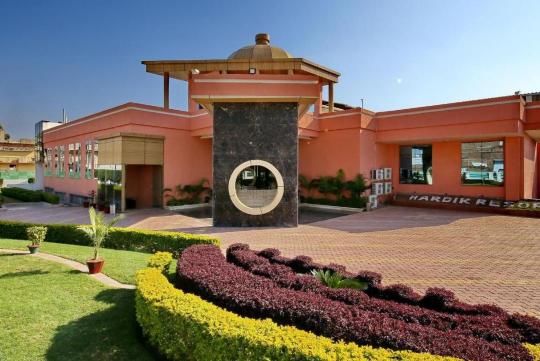


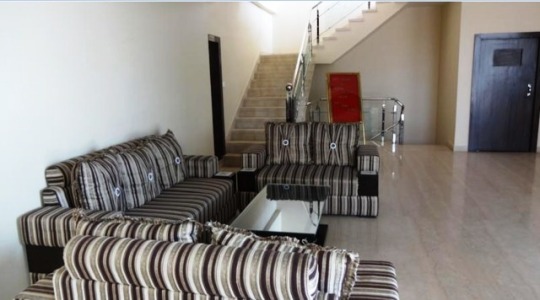



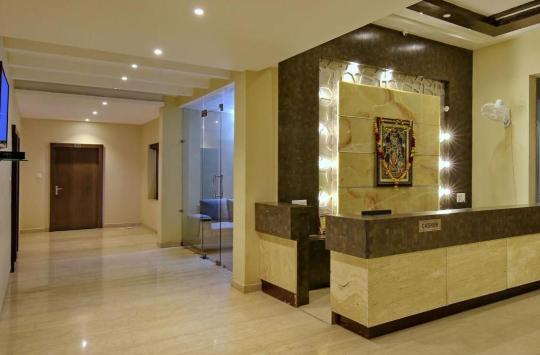

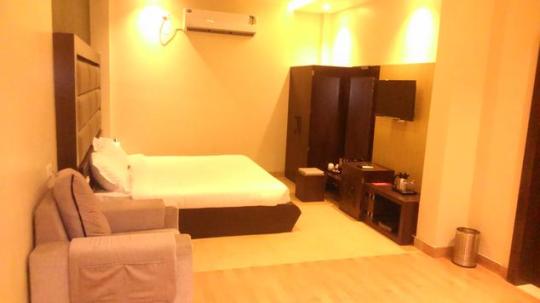
#HardikResort is a #3DAccommodation situated at a distance of 4 km from #OrchhaSanctuary and 27 km from Bijauli Railway Station. This property offers travel assistance to its guests. Each room is #WellEquippedWithBasicAmenities like a #Wardrobe, #Desk, #BottledDrinkingWater, and an #AttachedBathroom with a #ConstantSupplyOfHot and #ColdWater.
#AdditionalServicesProvided within the premises are #Laundry, #DoctorOnCall, and #24HourRoomService. This resort in #Orchha also has a #FrontDeskFacility, #BusinessCenterAndGardenArea. Guests can #DineInAtTheInHouse #MultiCuisineRestaurant. Hardik Resort in #OrchhaFeaturesABanquetHall. This property is located 16 km from #AmbedkarNagarBusStand and 27 km from #JhansiAirport. #MajorAttractionsIncludeRamRajaMandir (0.5 km) and #JahangirMahal (1 km.)
For Booking: https://bit.ly/2Y9YCmr
হার্দিক রিসোর্ট হল একটি 3D বাসস্থান যা ওরছা অভয়ারণ্য থেকে 4 কিমি এবং বিজৌলি রেলওয়ে স্টেশন থেকে 27 কিমি দূরে অবস্থিত। এই সম্পত্তি তার অতিথিদের ভ্রমণ সহায়তা প্রদান করে। প্রতিটি কক্ষ একটি মৌলিক সুবিধা যেমন একটি ওয়ারড্রোব, ডেস্ক, বোতলজাত পানীয় জল এবং একটি সংযুক্ত বাথরুম যেমন গরম এবং ঠান্ডা জলের ক্রমাগত সরবরাহ সহ সুসজ্জিত।
প্রাঙ্গনে প্রদত্ত অতিরিক্ত পরিষেবাগুলি হল লন্ড্রি, ডাক্তারের উপর ডাক্তার এবং 24-ঘন্টা রুম পরিষেবা। ওরছার এই রিসোর্টে একটি ফ্রন্ট ডেস্ক সুবিধা, ব্যবসা কেন্দ্র এবং একটি বাগান এলাকা রয়েছে। অতিথিরা অভ্যন্তরীণ মাল্টি-কুইজিন রেস্তোরাঁয় খেতে পারেন। ওরছার হার্দিক রিসোর্টে একটি ব্যাঙ্কুয়েট হল রয়েছে। এই সম্পত্তি আম্বেদকর নগর বাস স্ট্যান্ড থেকে 16 কিমি এবং ঝাঁসি বিমানবন্দর থেকে 27 কিমি দূরে অবস্থিত। প্রধান আকর্ষণগুলির মধ্যে রয়েছে রাম রাজা মন্দির (0.5 কিমি) এবং জাহাঙ্গীর মহল (1 কিমি)।
हार्दिक रिसॉर्ट हे 3 डी निवास आहे जे ओरछा अभयारण्यापासून 4 किमी आणि बिजौली रेल्वे स्टेशनपासून 27 किमी अंतरावर आहे. ही मालमत्ता आपल्या पाहुण्यांना प्रवास सहाय्य देते. प्रत्येक खोलीत अलमारी, डेस्क, बाटलीबंद पिण्याचे पाणी आणि गरम आणि थंड पाण्याच्या सतत पुरवठ्यासह संलग्न स्नानगृह अशा मूलभूत सुविधांनी सुसज्ज आहे.
आवारात पुरवलेल्या अतिरिक्त सेवा म्हणजे कपडे धुणे, डॉक्टर ऑन कॉल आणि 24 तास रूम सर्व्हिस. ओरछा येथील या रिसॉर्टमध्ये फ्रंट डेस्क सुविधा, बिझनेस सेंटर आणि गार्डन एरिया आहे. अतिथी इन-हाऊस मल्टी-क्युझिन रेस्टॉरंटमध्ये जेवू शकतात. ओरछा येथील हार्दिक रिसॉर्टमध्ये बँक्वेट हॉल आहे. ही मालमत्ता आंबेडकर नगर बस स्टँडपासून 16 किमी आणि झाशी विमानतळापासून 27 किमी अंतरावर आहे. मुख्य आकर्षणांमध्ये राम राजा मंदिर (0.5 किमी) आणि जहांगीर महल (1 किमी.)
#हार्दिकरिज़ॉर्ट #एक3डीआवास है जो #ओरछा अभयारण्य से 4 किमी और #बिजौलीरेलवेस्टेशन से 27 किमी की दूरी पर स्थित है। यह संपत्ति अपने मेहमानों को यात्रा सहायता प्रदान करती है। #प्रत्येककमराएकअलमारी, #डेस्क, #बोतलबंदपेयजल, और #गर्मऔरठंडेपानी की निरंतर आपूर्ति के साथ #एकसंलग्नबाथरूम जैसी बुनियादी सुविधाओं से सुसज्जित है।
परिसर के भीतर प्रदान की जाने वाली #अतिरिक्तसेवाएंकपड़ेधोने, #डॉक्टरऑनकॉल और #24घंटेकीरूमसर्विस हैं। ओरछा के इस रिसॉर्ट में #एकफ्रंटडेस्कसुविधा, #व्यापारकेंद्र और #एकउद्यानक्षेत्र भी है। मेहमान #इनहाउसबहुव्यंजनरेस्तरां में भोजन कर सकते हैं। ओरछा में हार्दिक रिज़ॉर्ट में #एकबैंक्वेटहॉल है। यह संपत्ति #अंबेडकरनगरबसस्टैंड से 16 किमी और #झांसीहवाईअड्डे से 27 किमी दूर स्थित है। #प्रमुखआकर्षणोंमेंरामराजामंदिर (0.5 किमी) और #जहांगीरमहल (1 किमी।)
Hotel Name: Hardik Resort
Address: Behind Foolbagh Temple, Raja Ram Colony, Orachha, Madhya Pradesh 472246
For Booking and Enquiry:
+919870334440
#AHR
#AsiaHotelsAndResorts
0 notes
Photo

Good News for Business Owners of Rajkot and Saurashtra.. Launching Repeat class of session 1 Business Training Batch for Business Owners. Housefull batch. 29th July 2021. Life Transformer Business Training and coaching services Pvt Ltd. At Life Transformer, we are in the business of improving the performance of your Business & human capital investment. We provide customized solutions to meet your organization’s specific challenges and provide significant and measurable outcomes. We provide personalized service that can help your organization achieve greater levels of workforce performance and productivity. What is BNS? BNS is a Business and Self Transformation Training Program where Businessmen / Entrepreneurs will learn to. 1) Importance of Business Automation 2) Build Organization with System, Process & Culture 3) Develop Employee Performance Measurement system 4) Replacement Theory of Business 5) Leadership System in Organization 6) Implementation of Idea into action 7) Time & Priorities Management 8. Build your Memory Power 9) Transform your Personality 10) Become Great Communicator 11) Expert in Public Speaking 12) Become a Fearless Businessman 13) Master in Human Relationship 14) Develop corporate habits of highly successful people 15) Setting Personal and Professional Goal Program Features. A. Program Duration – 1 year B. Training Session – 12 C. Monthly Session – 1 D. Date – 29th July 2021 Hotel – Saiyaji, Rajkot E. Date – 10th Aug 2021 Hotel – 7 season resort, Jamnagar F. Time – 8am to 12. Pm G. Program Fees – 30,000/- + GST (Guest Fees - Rs. 500) H. Trainer – Hardik Majithia Director of Life Transformer Pvt. Ltd For more information Mr. Akshay Rughani Contact - 9033757339, 8401282690, 9898588315 [email protected] www.lifetransformer.in https://www.instagram.com/p/CRwfPvbqlXg/?utm_medium=tumblr
0 notes
Text
Media as the Fourth Pillar of Democracy
In this article, Ranjeet Soni discusses the position of Media as a Fourth Pillar of Democracy.
“…WE, THE PEOPLE OF INDIA, having solemnly resolved to constitute India into a SOVEREIGN SOCIALIST SECULAR DEMOCRATIC REPUBLIC…”
“The moment we no longer have a free press, anything can happen. What makes it possible for a totalitarian or any other dictatorship to rule is that people are not informed.”
-Hannah Andret[1]
Media makes us aware of various social, political and economic activities around us. It is like a mirror which reveals us the bare truth and harsh realities of life. A news media, be it in print form or TV/radio, its main job is to inform people about unbiased news without any censorship or tampering. People always trust actual and honest news. The media also has its own opinion. But they can only put it in their own personal space (editorials) leaving it for the public to make its own assessment. At the same time, they have to incorporate other opinions too, however contradicting the editor’s view might be. The purpose of news media is to present accurate news and all types of views in front of people. That way they maintain their credibility. The Media is considered to be a two sides weapon. An accountable media can lift the nation to heights by providing a sturdy support for its development and an unaccountable media can cause disarray in the society.[2]
Democracy is considered to be a rule of the people through their elected representatives. One of the merits of a democratic system is the freedom of expression and the space that is provided to disagreement by different sections of society. For the democratic system to operate to its full potential, the participation on a part of the public is imperative, that successively needs circulation of reliable info to the masses on numerous public problems. This is where the mass media come in.
CORPORATIZATION OF MEDIA HOUSES
The true test of vibrant democracy is the independence of media. Over a past few year media in our country has become advocates of different political parties and voice of corporates. What happened in the electronic era is that mainstream media became corporatized to spread its business as well as to acquire advanced infrastructure. To corporatize, it required corporate financing. Entry of corporates brought in the culture of profiteering and that culture first killed the neutrality of news media. Corporates get most profit if they can be close to the broker lobby of power. “Power corrupts and absolute power corrupts even more[3]”. Thus, many news media started selective reporting. Apart from that they instead of presenting views started imposing views.
Journalism in our country is facing significant crisis.[4] In the race of sensationalism and TRP, media houses have taken a corporate turn. Courtesy to the media house they have made people like Kanhaiya kumar and Hardik patel an overnight celebrity. News which is TRP generating are shown in repetitive loops, while notable news gets neglected. We can say its selective when it comes to coverage. Assam’s floods did not get the required coverage as at that time Pratyusha Banerjee’s suicide was telecasted for TRP. Media houses have resorted so low that they are willing to compromise national security and secrecy. Be it broadcasting 26/11 or questioning surgical strikes. To gain popularity and profits they have started framing accusations on IB, Supreme Court and even Army.
Click Here
Recently Former Indian President Pranab Mukherjee resoundingly made point to the Indian media that “discussion and dissension are crucial for a spirited democracy, and it must hold public institutions accountable for all their actions and inactions. There should always be room for the argumentative Indian, and not the intolerant Indian. The media must be the watchdog, the mediator between the leaders and the public”.
POLITICAL DOMINANCE
India is such a populated and diverse country that its democratic life is hard contemplate. So is the range of media through which political opinions can be expressed. The media, regrettably, like the political polarization in the country, is also divided into anti-government, pro-government, and rightist groups with each entity trying to impose its own partisan views on serious national issues and even resorting to tarnish work of their rivals. Consequently, truth and social responsibility have become casualties of this uncontrolled media culture. Media expansion has led to a shrinking of the public sphere, resulting in the spread of elitist’s opinions.
The Indian media has now become the B team of the government. It is intently indulging in creating such pranks in the society and vitiating the already charged atmosphere with political war games. This doctrine clearly spells out the fact that there is always a ‘limitation’ for freedom of speech or rather freedom to sloganeering if that prank likely to harm the society. This is exactly what happened during the last ‘intolerance’ and award wapsi era under Modi Government on a Dadri prank.[5]
“As hard as it is to believe, the biggest thing that drives elections is simple name recognition by media”[6]. Media has now become a tool for political parties to brainwash the public by showing fabricated predicted votes via exit polls. Obviously, they can influence voter’s perceptions about the closeness of the election and the value of their votes. Campaigns are now getting covered like a sport with a special emphasis on who’s up, who’s down, who’s winning, who’s losing, how they are moving ahead or behind in the polls. Surprisingly, exit polls aren’t the only medium to influence opinion and spread rumors among voters. In this age of social media, it wouldn’t be too difficult to make impressions, courtesy the mammoth internet armies most media houses have. Word-of-mouth, village meets, informal gatherings – there are more than just one means through which ideas can be spread among voters.[7]
RELIGIOUS DOMINANCE
According to 2006 research report, “Indian media lacks social diversity and it doesn’t reflect the social profile of country. Mainly Hindu upper caste dominate in the media houses. They constitute around 8 % of India’s population but among the key decision makers of the national media, their share is as high as 71%”. Serious issues like the beef ban, Kashmir crisis, protests in universities and even where Dalits getting discriminated or killed, have received hardly any mention in media coverage. According to 2018 report, abysmal position of India at 138 among 180 countries in the latest annual World Press Freedom Index, which is another worrying point for Dalits and minority communities.
It is ‘pseudo secularism’ supported by Leftist outfits, and media houses. So in Indian context, though the Muslims are most the powerful group with over 18 crore population in India, is still a minority in numerical perspective, and hence the biased media houses go berserk in taking a side of only Muslims in all conflicts of ideology, religious bigotry, communal riots, human rights abuse etc. These groups blindly extended support to Jains, Buddhists, Christians etc. with a top priority for Muslims.
MEDIA TRIALS
“Media trial is a matter of serious concern. In my view, it should not be held. Media trial creates a perception of prejudice against the accused. Judgment should be delivered in court only”.[8]
In a one hour debating by news channels in which accused is framed with allegations and debated by some so called “experienced people of that field” after which the anchor gives an instant predefined verdict, which is definitely more captivating, amusing to public rather than the multifaceted and apodictic judicial procedure established by law of Indian judiciary, to which the most citizens are unaware. The journalists have started acting more or less as both prosecution and judge alleging, shouting, pronouncing verdicts.
As Article 19(1)(a) of the Indian Constitution guarantees freedom of speech and expression therefore, media has a firm hold in shaping the public opinion in any way it likes through its coverage of events which was also seen in the Arushi murder case of 2008[9]. Within the hours of the murder, various media men and reporters sock it to her house, tampering all over the evidence. The media boldly aired the news about the physical relationship of Aarushi and the male servant of Hemraj and the relationship of her father with a co-dentist. Even as the investigation began, a senior police official told reporters that Aarushi was “characterless”, which was used by reporters so much that the masses started to believe the contentions of the media. The plethora of the media provoked the supreme court to warn the media about the legit coverage of the case. Suggested to refrain from mudslinging on the character of the dead girl and her father.
MEDIA TRIAL v. FREE AND FAIR ADMINISTRATION OF JUSTICE
By conducting a parallel trial with the court, media often prejudices the judicial administration of a country by influencing the opinion of the judges. Sometimes, excessive publicity given to an accused or suspect by media before trial commences prejudices a fair trial thereby characterising him as a person who actually has committed the crime. This results in undue interference with the “administration of justice”, calling for proceedings for contempt of court against the media. Recently, Justice Joseph said that Media should play a constructive role in the betterment of the legal system while addressing a seminar on “Current Issues before the legal profession and the judiciary”. He also said that media must exercise due care and caution while reporting criminal matters to avoid any kind of disrespect to the Constitution and the judicial system in the country.
One of the examples in this respect is the case of Aarushi Talwar. In this case, media has played a major role in incriminating parents without any sufficient evidence. Likewise, there are many instances where the media has changed the whole way of perception. Media is often blamed of conducting the trial of the accused and passing the judgement even before the court thereby interfering with the judicial process.The trial is essentially a process to be carried out by the courts. Therefore, media must confine its role to reporting matters and not assuming the role of the court.
CONCLUSION
In any democracy, weakening of pillars is always damaging. We need to reach the main trunk, to trim the vicious aerial roots that are spreading and poisoning the society.
There are many factors that make media biased. There is racial, religious, political bias within the media. Media is not completely honest and objective in depiction of important issues. Certain issues are made to look by media in a certain way to benefit a certain group and manipulate the public opinion. Criticisms of social media range from criticisms of the ease of use of specific platforms and their capabilities, disparity in information available, issues with non-reliable and untrustworthy information presented, the impact of social media use on an individual’s opinion, ownership of media houses, and the meaning of interactions created by social media. There is a real risk that we will slide into a vicious cycle.
This spells danger for the future of democracy in India, unless it is urgently remedied. This problem can be solved in two ways, first being, democratic that is, through discussions, consultations and persuasion and other way is by using retributive measures against the media, for example, by imposing heavy fines on defaulters, stopping government advertisements to them, suspending their licenses etc.
To protect the pillars of democracy will not be an easy task in a current culture cracked by dissension and misleading information. It will require acumen and patience. Nevertheless, I believe that we will eventually restore our government on rail to work for the public good based on rationality and honesty. As great Martin Luther King Jr. said “The ultimate measure of a man is not where he stands in moments of comfort and convenience, but where he stands at a time of challenge and controversy”.
[1] American philosopher and political theorist
[2] Hon Dr Victor Dan-Jumbo, Pillars of Democracy (first published 2014, hillsberg) 15
[3] Lord Acton, English politician and writer
[4] Hon Dr Victor Dan-Jumbo, Pillars of Democracy (first published 2014, hillsberg) 13
[5] K V Patel, The Foundation Pillars for Change: Our Nation, Our Democracy & Our Future (first published 2014, Partridge Publishing) 174
[6] Regina Lawrence, executive director of the UO SOJC’s Agora Journalism Center & the co-author of “Hillary Clinton’s Race for the White House: Gender Politics and the Media on the Campaign Trail” and “When the Press Fails: Political Power and the News Media from Iraq to Katrina.”
[7] Goodspeed and Edgar CJ, Four Pillars of Democracy (first published 1940, Harper & Brothers) 214
[8] Amaltas kabir, 39th Chief Justice of India
[9] Dr. Rajesh talwar and Another V. Central Bureau Of Investigation, [2013] 82 ACC 303
The post Media as the Fourth Pillar of Democracy appeared first on iPleaders.
Media as the Fourth Pillar of Democracy syndicated from https://namechangersmumbai.wordpress.com/
0 notes
Text
Media as the Fourth Pillar of Democracy
In this article, Ranjeet Soni discusses the position of Media as a Fourth Pillar of Democracy.
“…WE, THE PEOPLE OF INDIA, having solemnly resolved to constitute India into a SOVEREIGN SOCIALIST SECULAR DEMOCRATIC REPUBLIC…”
“The moment we no longer have a free press, anything can happen. What makes it possible for a totalitarian or any other dictatorship to rule is that people are not informed.”
-Hannah Andret[1]
Media makes us aware of various social, political and economic activities around us. It is like a mirror which reveals us the bare truth and harsh realities of life. A news media, be it in print form or TV/radio, its main job is to inform people about unbiased news without any censorship or tampering. People always trust actual and honest news. The media also has its own opinion. But they can only put it in their own personal space (editorials) leaving it for the public to make its own assessment. At the same time, they have to incorporate other opinions too, however contradicting the editor’s view might be. The purpose of news media is to present accurate news and all types of views in front of people. That way they maintain their credibility. The Media is considered to be a two sides weapon. An accountable media can lift the nation to heights by providing a sturdy support for its development and an unaccountable media can cause disarray in the society.[2]
Democracy is considered to be a rule of the people through their elected representatives. One of the merits of a democratic system is the freedom of expression and the space that is provided to disagreement by different sections of society. For the democratic system to operate to its full potential, the participation on a part of the public is imperative, that successively needs circulation of reliable info to the masses on numerous public problems. This is where the mass media come in.
CORPORATIZATION OF MEDIA HOUSES
The true test of vibrant democracy is the independence of media. Over a past few year media in our country has become advocates of different political parties and voice of corporates. What happened in the electronic era is that mainstream media became corporatized to spread its business as well as to acquire advanced infrastructure. To corporatize, it required corporate financing. Entry of corporates brought in the culture of profiteering and that culture first killed the neutrality of news media. Corporates get most profit if they can be close to the broker lobby of power. “Power corrupts and absolute power corrupts even more[3]”. Thus, many news media started selective reporting. Apart from that they instead of presenting views started imposing views.
Journalism in our country is facing significant crisis.[4] In the race of sensationalism and TRP, media houses have taken a corporate turn. Courtesy to the media house they have made people like Kanhaiya kumar and Hardik patel an overnight celebrity. News which is TRP generating are shown in repetitive loops, while notable news gets neglected. We can say its selective when it comes to coverage. Assam’s floods did not get the required coverage as at that time Pratyusha Banerjee’s suicide was telecasted for TRP. Media houses have resorted so low that they are willing to compromise national security and secrecy. Be it broadcasting 26/11 or questioning surgical strikes. To gain popularity and profits they have started framing accusations on IB, Supreme Court and even Army.
Click Here
Recently Former Indian President Pranab Mukherjee resoundingly made point to the Indian media that “discussion and dissension are crucial for a spirited democracy, and it must hold public institutions accountable for all their actions and inactions. There should always be room for the argumentative Indian, and not the intolerant Indian. The media must be the watchdog, the mediator between the leaders and the public”.
POLITICAL DOMINANCE
India is such a populated and diverse country that its democratic life is hard contemplate. So is the range of media through which political opinions can be expressed. The media, regrettably, like the political polarization in the country, is also divided into anti-government, pro-government, and rightist groups with each entity trying to impose its own partisan views on serious national issues and even resorting to tarnish work of their rivals. Consequently, truth and social responsibility have become casualties of this uncontrolled media culture. Media expansion has led to a shrinking of the public sphere, resulting in the spread of elitist’s opinions.
The Indian media has now become the B team of the government. It is intently indulging in creating such pranks in the society and vitiating the already charged atmosphere with political war games. This doctrine clearly spells out the fact that there is always a ‘limitation’ for freedom of speech or rather freedom to sloganeering if that prank likely to harm the society. This is exactly what happened during the last ‘intolerance’ and award wapsi era under Modi Government on a Dadri prank.[5]
“As hard as it is to believe, the biggest thing that drives elections is simple name recognition by media”[6]. Media has now become a tool for political parties to brainwash the public by showing fabricated predicted votes via exit polls. Obviously, they can influence voter’s perceptions about the closeness of the election and the value of their votes. Campaigns are now getting covered like a sport with a special emphasis on who’s up, who’s down, who’s winning, who’s losing, how they are moving ahead or behind in the polls. Surprisingly, exit polls aren’t the only medium to influence opinion and spread rumors among voters. In this age of social media, it wouldn’t be too difficult to make impressions, courtesy the mammoth internet armies most media houses have. Word-of-mouth, village meets, informal gatherings – there are more than just one means through which ideas can be spread among voters.[7]
RELIGIOUS DOMINANCE
According to 2006 research report, “Indian media lacks social diversity and it doesn’t reflect the social profile of country. Mainly Hindu upper caste dominate in the media houses. They constitute around 8 % of India’s population but among the key decision makers of the national media, their share is as high as 71%”. Serious issues like the beef ban, Kashmir crisis, protests in universities and even where Dalits getting discriminated or killed, have received hardly any mention in media coverage. According to 2018 report, abysmal position of India at 138 among 180 countries in the latest annual World Press Freedom Index, which is another worrying point for Dalits and minority communities.
It is ‘pseudo secularism’ supported by Leftist outfits, and media houses. So in Indian context, though the Muslims are most the powerful group with over 18 crore population in India, is still a minority in numerical perspective, and hence the biased media houses go berserk in taking a side of only Muslims in all conflicts of ideology, religious bigotry, communal riots, human rights abuse etc. These groups blindly extended support to Jains, Buddhists, Christians etc. with a top priority for Muslims.
MEDIA TRIALS
“Media trial is a matter of serious concern. In my view, it should not be held. Media trial creates a perception of prejudice against the accused. Judgment should be delivered in court only”.[8]
In a one hour debating by news channels in which accused is framed with allegations and debated by some so called “experienced people of that field” after which the anchor gives an instant predefined verdict, which is definitely more captivating, amusing to public rather than the multifaceted and apodictic judicial procedure established by law of Indian judiciary, to which the most citizens are unaware. The journalists have started acting more or less as both prosecution and judge alleging, shouting, pronouncing verdicts.
As Article 19(1)(a) of the Indian Constitution guarantees freedom of speech and expression therefore, media has a firm hold in shaping the public opinion in any way it likes through its coverage of events which was also seen in the Arushi murder case of 2008[9]. Within the hours of the murder, various media men and reporters sock it to her house, tampering all over the evidence. The media boldly aired the news about the physical relationship of Aarushi and the male servant of Hemraj and the relationship of her father with a co-dentist. Even as the investigation began, a senior police official told reporters that Aarushi was “characterless”, which was used by reporters so much that the masses started to believe the contentions of the media. The plethora of the media provoked the supreme court to warn the media about the legit coverage of the case. Suggested to refrain from mudslinging on the character of the dead girl and her father.
MEDIA TRIAL v. FREE AND FAIR ADMINISTRATION OF JUSTICE
By conducting a parallel trial with the court, media often prejudices the judicial administration of a country by influencing the opinion of the judges. Sometimes, excessive publicity given to an accused or suspect by media before trial commences prejudices a fair trial thereby characterising him as a person who actually has committed the crime. This results in undue interference with the “administration of justice”, calling for proceedings for contempt of court against the media. Recently, Justice Joseph said that Media should play a constructive role in the betterment of the legal system while addressing a seminar on “Current Issues before the legal profession and the judiciary”. He also said that media must exercise due care and caution while reporting criminal matters to avoid any kind of disrespect to the Constitution and the judicial system in the country.
One of the examples in this respect is the case of Aarushi Talwar. In this case, media has played a major role in incriminating parents without any sufficient evidence. Likewise, there are many instances where the media has changed the whole way of perception. Media is often blamed of conducting the trial of the accused and passing the judgement even before the court thereby interfering with the judicial process.The trial is essentially a process to be carried out by the courts. Therefore, media must confine its role to reporting matters and not assuming the role of the court.
CONCLUSION
In any democracy, weakening of pillars is always damaging. We need to reach the main trunk, to trim the vicious aerial roots that are spreading and poisoning the society.
There are many factors that make media biased. There is racial, religious, political bias within the media. Media is not completely honest and objective in depiction of important issues. Certain issues are made to look by media in a certain way to benefit a certain group and manipulate the public opinion. Criticisms of social media range from criticisms of the ease of use of specific platforms and their capabilities, disparity in information available, issues with non-reliable and untrustworthy information presented, the impact of social media use on an individual’s opinion, ownership of media houses, and the meaning of interactions created by social media. There is a real risk that we will slide into a vicious cycle.
This spells danger for the future of democracy in India, unless it is urgently remedied. This problem can be solved in two ways, first being, democratic that is, through discussions, consultations and persuasion and other way is by using retributive measures against the media, for example, by imposing heavy fines on defaulters, stopping government advertisements to them, suspending their licenses etc.
To protect the pillars of democracy will not be an easy task in a current culture cracked by dissension and misleading information. It will require acumen and patience. Nevertheless, I believe that we will eventually restore our government on rail to work for the public good based on rationality and honesty. As great Martin Luther King Jr. said “The ultimate measure of a man is not where he stands in moments of comfort and convenience, but where he stands at a time of challenge and controversy”.
[1] American philosopher and political theorist
[2] Hon Dr Victor Dan-Jumbo, Pillars of Democracy (first published 2014, hillsberg) 15
[3] Lord Acton, English politician and writer
[4] Hon Dr Victor Dan-Jumbo, Pillars of Democracy (first published 2014, hillsberg) 13
[5] K V Patel, The Foundation Pillars for Change: Our Nation, Our Democracy & Our Future (first published 2014, Partridge Publishing) 174
[6] Regina Lawrence, executive director of the UO SOJC’s Agora Journalism Center & the co-author of “Hillary Clinton’s Race for the White House: Gender Politics and the Media on the Campaign Trail” and “When the Press Fails: Political Power and the News Media from Iraq to Katrina.”
[7] Goodspeed and Edgar CJ, Four Pillars of Democracy (first published 1940, Harper & Brothers) 214
[8] Amaltas kabir, 39th Chief Justice of India
[9] Dr. Rajesh talwar and Another V. Central Bureau Of Investigation, [2013] 82 ACC 303
The post Media as the Fourth Pillar of Democracy appeared first on iPleaders.
Media as the Fourth Pillar of Democracy published first on https://namechangers.tumblr.com/
0 notes
Text
Hardik Patel fears for life, says Amit Shah can get him killed
Hardik Patel, the firebrand young leader turned crusader for Patel reservation, has said that the BJP could get him killed if he returns to his home state of Gujarat. Patel claimed that Prime Minister Narendra Modi or his man Friday Amit Shah will do anything to win the upcoming Gujarat election and this includes getting him killed or jailed.
The 22-year-old Patel was ordered by the Gujarat High Court to leave the state for six months. The exile will come to an end on January 14 but Patel intends to leave from Udaipur, Rajasthan, where he is currently staying put, three days later. His supporters have planned a massive reception for his entry into Gujarat, and intend to greet him with a convoy of over 1,500 cars near the Shamlaji check post, which is close to the Rajasthan-Gujarat border. Patel expects around 2 lakh people to welcome him and plans to address a large gathering of Patidars in Himmatnagar on his return.
The Patel agitation caught the imagination of a sizeable number of Patel community members before and during a rally held in Gujarat in 2015. State police had to resort to lathicharge to disperse the crowd, which had allegedly turned raucous. The situation soon took a violent turn and spiraled out of control. The following days saw large scale arson, several deaths and huge damage to public property. Patel was then booked for sedition and was granted bail, under the conditions of which he sent on exile.
PATEL TARGETS MODI, GUJARAT CM
Patel recently scoffed at PM Modi's claims that the demonetisation drive has been successful and questioned why the PM didn't mention how much black money was brought back into the economy. Patel has previously called Modi's Gujarat model, which is touted by the PM's supporters, fake. According to him, Patidars have been ruined during the BJP's 20 years of 'misrule' in Gujarat. He has said that while people outside Gujarat consider Patidars to be affluent, in reality they have been left in tatters. Patel also criticized the current Gujarat Chief Minister Vijay Rupani, calling him a Modi man who has no interest in fulfilling the Patidars' demands and who is out to finish the Patels socially, politically and regionally.
BJP's ACHIELLES' HEEL?
The Hardik Patel-led Pattidar Anamat Andolan Samiti (PAAS) has the potential of becoming the Achilles' heel of Amit Shah's BJP. The party fears that it may suffer reverses if the Patel agitation takes off once again with Gujarat set to go to the polls before the end of this year. Shah recently got a taste of the resentment amidst the Patels during a large gathering in Surat that included several senior BJP leaders. Many protestors shouted, 'General Dyer go back', comparing the BJP president to the notorious British officer responsible for the Jalianwala Bagh massacre.
READ MORE:Hardik plans his Gujarat comeback with "Kisan Mahasabha" along with Nitish Kumar
#_lmsid:a0Vd0000002uQfeEAE#_revsp:india_today_57#_draft:true#_uuid:6b929b6c-31c7-3cbf-9455-76bb148001bb
1 note
·
View note